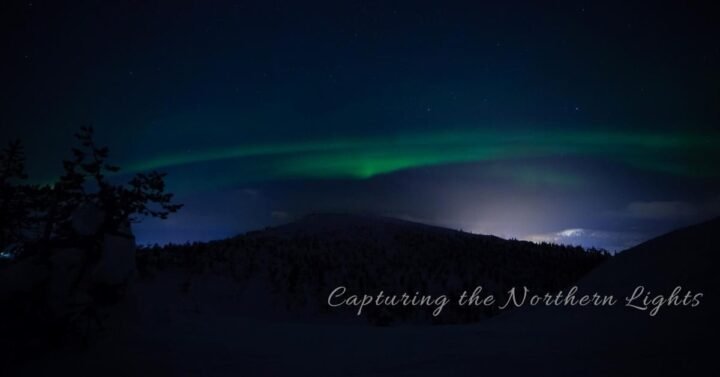How To Take Pictures Of The Northern Lights
Have you ever dreamt of witnessing the enchanting dance of the Northern Lights? Or perhaps capturing this celestial spectacle on your camera? Well, I have had the incredible opportunity to photograph the Northern Lights, and let me tell you, it’s an experience like no other. As an avid photographer and traveler, I’ve always been fascinated by the ethereal beauty of the aurora borealis.
How to Take Pictures Of The Northern Lights?
Capturing the Northern Lights is a bucket-list item for many photographers, and good reason. These dancing lights in the sky are a natural wonder that’s hard to beat. But getting that perfect shot takes more than just pointing your camera at the sky. It takes planning, patience, and the right equipment.
So, grab a cup of coffee, get comfortable, and let’s dive into the magical world of Northern Lights photography. By the end of this guide, you’ll be armed with all the knowledge and tips you need to capture your own stunning Northern Lights photos.
Let’s make your Northern Lights photography dreams a reality!
Understanding the Northern Lights: A Brief Primer
Before we delve into the technicalities of photography, let’s take a moment to understand the Northern Lights themselves. Also known as the Aurora Borealis, the Northern Lights are a natural light display caused by the interaction of charged particles from the sun with the Earth’s atmosphere. These particles collide with atoms in the atmosphere, exciting them and causing them to emit light.
The result is a breathtaking display of colors, typically green, but sometimes also red, pink, yellow, blue, and violet. The Northern Lights can appear in various forms, from arcs and bands to curtains and rays, each one a unique and mesmerizing sight.
Planning Your Northern Lights Adventure – How To Take Pictures Of The Northern Lights
Capturing the perfect shot of the Northern Lights starts long before you even set foot outside. Proper planning is crucial to ensure you’re in the right place at the right time, with the right gear in hand. Here are some key aspects to consider:
1. Timing is Everything: When to See the Northern Lights
The Northern Lights are most visible during the winter months, from late September to late March when the nights are longer and darker. However, the exact timing can vary depending on your location and the solar activity. It’s best to check the aurora forecast for your chosen location before you go.
2. Location, Location, Location: Where to See the Northern Lights
The Northern Lights are most visible in the auroral zone, a ring-shaped region around the Earth’s magnetic poles. This includes places like Alaska, Canada, Iceland, Norway, Sweden, and Finland. However, with the right conditions, the Northern Lights can be seen further south as well.
3. Pack Your Bags: What to Bring for Northern Lights Photography
- DSLR or mirrorless camera: A camera with manual settings is essential for Northern Lights photography.
- Wide-angle lens: A lens with a wide field of view (10-24mm) is ideal for capturing the vastness of the aurora.
- Tripod: A sturdy tripod is crucial for long-exposure shots.
- Remote shutter release: This will help prevent camera shake during long exposures.
- Extra batteries: Cold temperatures can drain batteries quickly, so pack extras.
- Headlamp or flashlight: This will help you see in the dark and adjust your camera settings.
- Warm clothing: Dress in layers to stay warm in the cold weather.
Camera Settings for Northern Lights Photography – How To Take Pictures Of The Northern Lights
Now that you’re all set up and ready to go, let’s talk about the camera settings you’ll need to capture those stunning Northern Lights shots. Remember, these are just starting points, and you may need to adjust them based on the conditions and your camera.
1. Shoot in Manual Mode
Manual mode gives you full control over your camera’s settings, allowing you to adjust them to the specific conditions. This is crucial for Northern Lights photography, where the light levels can vary significantly.
2. Aperture (f-stop)
Open up your aperture as wide as possible (f/2.8 or lower) to let in as much light as possible. This will also help create a shallow depth of field, blurring the foreground and background and making the Northern Lights stand out.
3. ISO
Start with an ISO of 1600 and adjust up or down depending on the brightness of the aurora. Higher ISO settings will make your camera more sensitive to light, but they can also introduce noise into your photos.
4. Shutter Speed
The shutter speed you choose will depend on the brightness of the aurora and how much movement you want to capture. A good starting point is 15 seconds, but you may need to adjust it based on the conditions.
5. Focus
Set your focus to manual and focus on a bright star or a distant light source. This will ensure that your photos are sharp and in focus.
6. White Balance
Set your white balance to auto or daylight. This will help ensure that the colors in your photos are accurate.
Tips and Tricks for Stunning Northern Lights Photos
Now that you know the basics, here are some additional tips and tricks to help you capture truly stunning Northern Lights photos:
- Shoot in RAW format: This will give you more flexibility when editing your photos later.
- Use a remote shutter release or self-timer: This will help prevent camera shake during long exposures.
- Experiment with different compositions: Don’t just point your camera at the sky. Try including some foreground elements, such as trees or mountains, to add interest to your photos.
- Take multiple shots: The Northern Lights are constantly changing, so take multiple shots to capture different forms and colors.
- Edit your photos: Even the best photos can benefit from some editing. Use photo editing software to adjust the exposure, contrast, and color balance of your photos.
Additional Tips: How To Take Pictures Of The Northern Lights
As a Nigerian, you might be wondering if it’s possible to see the Northern Lights from here. While it’s not a common occurrence, it’s not entirely impossible either. If you’re lucky enough to have a clear night with high solar activity, you might just be able to catch a glimpse of the aurora from the northernmost parts of the country.
If you’re planning a trip to a location where the Northern Lights are more visible, here are some additional tips:
- Check the aurora forecast: This will give you an idea of the likelihood of seeing the Northern Lights on any given night.
- Find a dark location: Light pollution can obscure the Northern Lights, so try to find a location away from city lights.
- Be patient: The Northern Lights can be elusive, so be prepared to wait and watch.
- Have fun! Capturing the Northern Lights is an incredible experience, so enjoy the moment and don’t get too caught up in the technicalities.
FAQs – How To Take Pictures Of The Northern Lights
Can you take pictures of the Northern Lights with a phone?
Yes, you can! While a DSLR or mirrorless camera offers more control and better image quality, modern smartphones with good low-light capabilities can capture decent Northern Lights photos. Look for a phone with manual mode or a dedicated Night Mode, and use a tripod for stability.
How to photograph the Northern Lights for beginners?
Choose the right location and time: Research the best places and times to see the Northern Lights.
Use the right gear: A DSLR or mirrorless camera with a wide-angle lens and tripod is ideal.
Set your camera settings: Use manual mode, a wide aperture (f/2.8 or lower), high ISO (1600 or higher), and a long shutter speed (15 seconds or more).
Focus manually: Focus on a bright star or distant light source.
Experiment and have fun: Try different compositions and settings to find what works best for you.
How to take pictures of the Northern Lights with an iPhone?
Use Night mode: If your iPhone has Night mode, turn it on for better low-light performance.
Use a tripod: This will keep your phone steady for long exposures.
Consider using a third-party app: Apps like NightCap Camera or ProCamera offer more manual controls for better results.
How do you use a camera to see the Northern Lights?
Cameras with long exposure settings are more sensitive to light than our eyes, allowing them to “see” and capture the Northern Lights even when they appear faint to the naked eye.
Can the naked eye see the Northern Lights?
Yes, you can see the Northern Lights with the naked eye, but they may appear faint or less colorful than in photos. A camera with long exposure can capture more of their vibrancy and detail.
Which camera can capture Northern Lights?
Any DSLR or mirrorless camera with manual settings can capture the Northern Lights. However, cameras with good low-light performance and a wide dynamic range will produce better results.
How to take pictures of the Northern Lights with Samsung?
If your Samsung phone has Pro Mode, use it to manually adjust settings like aperture, ISO, and shutter speed. If not, try using the Night mode or a third-party app for better low-light photography.
What is the best time to see the Northern Lights?
The best time to see the Northern Lights is during the winter months, from late September to late March.
Where is the best place to see the Northern Lights?
The best place to see the Northern Lights is in the auroral zone, a ring-shaped region around the Earth’s magnetic poles. This includes places like Alaska, Canada, Iceland, Norway, Sweden, and Finland.
What kind of camera do I need to photograph the Northern Lights?
A DSLR or mirrorless camera with manual settings is ideal for Northern Lights photography.
What are the best camera settings for Northern Lights photography?
The best camera settings for Northern Lights photography vary depending on the conditions, but a good starting point is:
Aperture: f/2.8 or lower
ISO: 1600
Shutter speed: 15 seconds
Conclusion – How To Take Pictures Of The Northern Lights
Photographing the Northern Lights can be a challenging but rewarding experience. With the right planning, equipment, and techniques, you can capture stunning photos that will last a lifetime. Remember, the most important thing is to have fun and enjoy the beauty of this natural wonder.
I hope this comprehensive guide has equipped you with everything you need to embark on your own Northern Lights photography adventure. If you have any questions or need further assistance, feel free to drop a comment below.
Remember, the key to capturing the perfect Northern Lights photo is a combination of preparation, patience, and a dash of luck. So, get out there, explore, and let the magic of the aurora borealis inspire your creativity!
Happy shooting!






